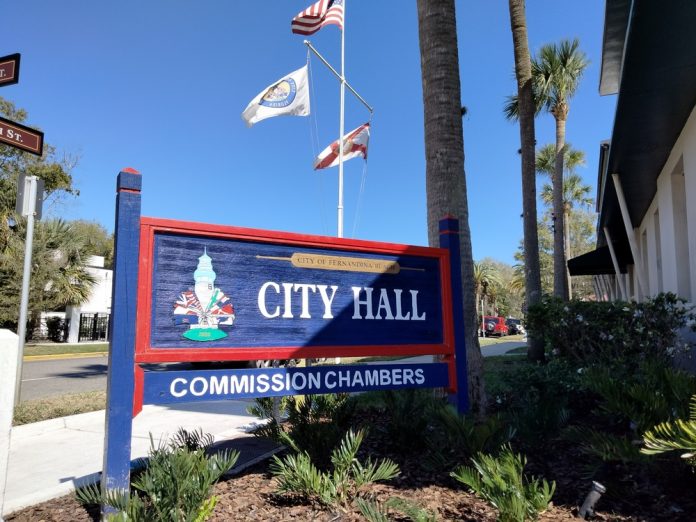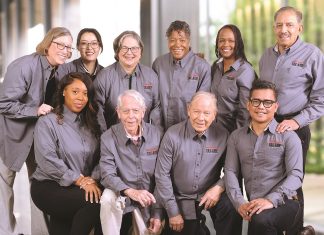By Julia Roberts
The Fernandina Beach City Commission is still considering its options in the legal proceedings between the city and Rayonier Advanced Materials (RYAM) regarding a bioethanol plant the company wants to build in the city.
RYAM applied to the Florida Department of Environmental Protection for an air quality permit which would allow the company to build a second-generation project plant that will use spent sulfite liquor, a product of its process at the plant, as the basis for ethanol fermentation. The proposed plant would be capable of producing approximately 7.5 million gallons of bioethanol for sale each year. That permit was approved.
The public has voiced opposition to the project, citing environmental concerns as well as questions regarding transporting the product and the potential for an environmental disaster with the volatile chemicals used in the process. There are also questions as to how the plant could be built in the city, as its Comprehensive Plan and Land Development Code forbids the manufacture of chemicals in city limits. The city asked an outside law firm to study the issue and give the city commission an opinion. That opinion was, under current regulations, the plant could not be built. The city therefore denied a building permit for the project.
However, RYAM has filed legal action in an attempt to move forward with the project, which includes two lawsuits and a letter to the city informing its attorney, Teresa Prince, the company intends to file a Bert Harris claim. Under the Bert Harris act, a claim exists if a governmental entity inordinately burdens an existing use of real property or a vested right to a specific use of real property. RYAM’s action says the city, by refusing to issue a building permit for the bioethanol facility, has caused the value of its property to decline to the tune of $6 million.
At the Oct. 8 city commission meeting, Prince told commissioners the city was responding solely to the intention to file a Bert Harris claim, not the legality of the proposed use, or adequacy of the city’s review of the application, whether or not the application is for a chemical manufacturing use, the adequacy of the appraisal attached to the claim or the two pending litigation matters (federal and state) over the city’s denial of the application.
The attorney said the city has until Nov. 10 to respond to its letter of intention to file a Bert Harris claim, and gave commissioners a list of 11 actions they could do in response.
The city could make an adjustment of land development or permit standards to allow the plant to be built; increase or modify the density, intensity, or use of areas of development; transfer the development rights; make a land swap or exchange; mitigate, including payments in lieu of onsite mitigation; allow a move to a location on the least sensitive portion of the property; condition the amount of development or use permitted; require issues be addressed on a more comprehensive basis than a single proposed use or development; issue the development order, a variance, a special exception, or give other extraordinary relief; purchase the property, or an interest therein; or, make no changes to the action of the governmental entity, which is to deny the building permit.
Prince said it was her legal opinion that the city commission could only approve the final option, of taking no action to change the decision to deny the permit, or to push the matter to a future date in order to allow the commission time for further research and consideration.
Several members of the public addressed the commission with opinions on what action the city should take regarding RYAM’s intention to build the plant, including members of No Ethanol Fernandina, a nonprofit formed to legally oppose the facility. Frank Hileman, the chair of the organizations’ Board of Directors, urged the city commission not to offer a settlement to RYAM.
“If the city commission overrides the Comprehensive Plan and Land Development Code and enters into a settlement agreement with RYAM, this would require the city and RYAM to jointly file an action in Circuit Court for approval of the settlement agreement and requesting the court determine whether the relief granted protects the public interest served by the statute at issue and is the appropriate relief necessary to prevent the governmental regulatory effort from inordinately burdening the real property,” Hileman said.
Other speakers, which included chemists and chemical engineers, addressed not only the legality of the plant, but the issues of health and safety which they believe would be affected by the facility.
John Hart said the city should not make decisions regarding the proposed plant without a hazard analysis of the potential harm from the plant.
“If the city and RYAM were willing to discuss options based on decision-quality information as to the safety of the plant and the environmental risk, I believe there would be numerous options that would acceptably resolve this dispute,” Hart said. “But at present, that decision-quality information does not exist. It is a hazard analysis. A hazard analysis is simply the first step to determine the safety of a project of this nature and this location. What is needed is a full quantitative risk study. That study, by properly certified engineers, would assess hazards to know, run … simulations, make probability assessments and prioritize mitigation strategies.
“I believe the best path at this point in time is to find out whether RYAM is truly a willing partner, and the way to do that is to say ‘no’” Hart said. “If you really don’t have reliable information, and if you negotiate without the proper information, you are dancing in the dark.”
Other speakers spoke less about legalities and more about the human cost they think Fernandians, and those in proximity to the plant, would be forced to pay.
Dr. Lisa White is a research scientist, who said she has investigated childhood cancer clusters (geographic areas where a higher-than-expected number of cases of the same type of cancer occur over a specified period of time) which she said “tend to be grouped around entities like this bioethanol plant.” She said building the bioethanol plant is a “move off the island” event for her.
“When there is a fire, when there is some kind of problem over there, it is going to decimate the island, and possibly bridge to get off the island,” White said. “There is a nuclear installation of submarines at St. Marys and Kings Bay that is within the blast radius.
“There is only one thing that matters to me: human life,” Dr. White said. “This is not conducive to human life continuing on this island. I don’t know when something will happen, but something will happen. Do we pick money for RYAM or do we pick human existence, safe human existence?”
While more than 20 speakers addressed the commission and most of them spoke against the plant, some want the city to consider the relationship Rayonier has had with the city for the biggest part of a century.
Mark Cutshaw is the board chair of the Nassau County Economic Development Board. He advocated the city submit a settlement offer to RYAM.
“Clarity is what we need in this,” Cutshaw said. “We don’t need to drag it out. New businesses are not coming to Nassau County because of this. Get this thing behind us. Jobs and businesses in the future count on it. How many homes and small businesses do we need to make up (for) that tax revenue that we would get from this one investment?”
Cutshaw said RYAM was one of the founding companies that “made Fernandina Beach … they are going to be here to support us, going forward.”
City commissioner Genece Minshew said she is opposed to the plant.
“I do not believe it serves the city in any valuable way,” Minshew said. She shared a list of issues regarding the plant she believes need to be reviewed. Those issues include questions about air quality monitoring, how ethanol would be transported and the amount of it that would be produced, evacuation plans, community awareness of conditions of the plant and the ability of the city’s fire department to deal with emergencies associated with the plant.
Vice Mayor Darron Ayscue emphasized the need for communication between the city and RYAM.
“The whole point of the matter is to open discussions,” Ayscue said. He said, while he has not replied to emails about the matter due to concerns of speaking publicly about ongoing litigation, he has read them all and understands concerns that have been brought to him.
“There has to be some form of getting us all in a room and talking,” the vice mayor said. “I’m not willing to just shut the door and stick my head in the sand and say this is going to go away at some point. It’s not going to go away if we just continue to ignore it.”
Commissioner Tim Poynter said that he has no expertise in the field of chemical engineering, and he does not want to enter into a discussion about it until he gets information from those who know about it, but he has reservations.
“It doesn’t make any sense, for safety, for the environment, it literally makes no sense,” Poynter said. “Right now, I have no information whatsoever that I can make any type of decision on.”
Mayor James Antun reiterated that the discussion was not about the finer points of bioethanol or the legality of the proposed plant. After discussion, the commission voted to postpone the discussion until the city can obtain more information. The matter could be discussed at the commission’s Oct. 21 meeting, and action, if the commission decides to take action, could be taken at the Nov. 4 meeting.
jroberts@nassaunewsline.net











